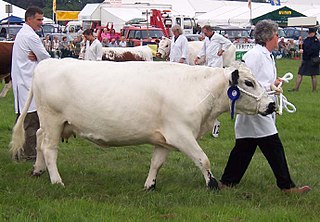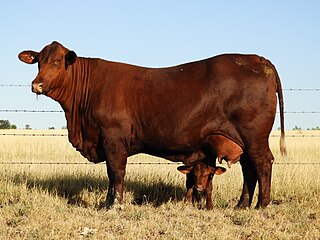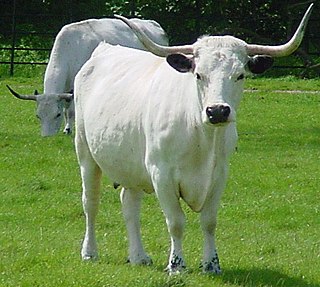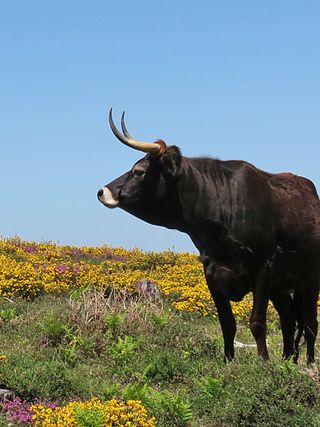![Cow of the Norwegian Sidet tronderfe og nordlandsfe [sv] breed STN Cow.jpg](http://upload.wikimedia.org/wikipedia/commons/thumb/e/ee/STN_Cow.jpg/220px-STN_Cow.jpg)
Colour-sided is a colour pattern of domesticated cattle. It is sometimes called lineback.
![Cow of the Norwegian Sidet tronderfe og nordlandsfe [sv] breed STN Cow.jpg](http://upload.wikimedia.org/wikipedia/commons/thumb/e/ee/STN_Cow.jpg/220px-STN_Cow.jpg)
Colour-sided is a colour pattern of domesticated cattle. It is sometimes called lineback.
The pattern consists of a dark body colour, with white finching along the spine, white under the belly, and often white also over the tail, head and legs. The ears, nose and feet are generally dark. The dark colour may be any solid colour such as black, red or brindle. The pattern may occur in many breeds, but some breeds are consistently colour-sided; these include the English Longhorn, and the Irish Moiled in the British Isles, and the Randall Lineback in the United States. Among other breeds that frequently display the pattern are the Texas Longhorn, the Florida Cracker and some African and Scandinavian breeds; it is also seen in the Belgian Blue, where it is called 'Witrik'. [1] : 48 [2] : xxii, 127 A similar colour pattern is seen in the domestic yak [1] : 48 and in some zebuine cattle. [3]
An extreme pale form of the colour-sided pattern is the colour-pointed or 'white park' pattern, seen for example in the White Park, the British White and in some Irish Moiled, where the darker colour is restricted to the ears, nose and feet, leaving most of the animal white. [2] : 127
Colour-sidedness was discussed in The Journal of Heredity in 1925 by Christian Wriedt, who probably coined the term. [4] : 465 [3] : 51
The mechanism of transmission of the colour-pointed pattern was identified and investigated in 2011–2013 by Keith Durkin, Bertram Brenig and others. [2] : xxii It involves an unusual translocation, through a ring-shaped intermediate DNA fragment, of the KIT gene between chromosomes 6 and 29. [5] : 81 [6] : 451 [7] No genetic mutation of this type had previously been identified. [2] : 127

The Texas Longhorn is an American breed of beef cattle, characterized by its long horns, which can span more than 8 ft (2.4 m) from tip to tip. It derives from cattle brought from the Iberian Peninsula to the Americas by Spanish conquistadores from the time of the Second Voyage of Christopher Columbus until about 1512. For hundreds of years the cattle lived a semi-feral existence on the rangelands; they have a higher tolerance of heat and drought than most European breeds. It can be of any color or mix of colors. In some 40% of the cattle it is some shade of red, often a light red; the only shade of red not seen is the deep color typical of the Hereford.

Roan is a coat color found in many animals, including horses, cattle, antelope, cat and dogs. It is defined generally as an even mixture of white and pigmented hairs that do not "gray out" or fade as the animal ages. There are a variety of genetic conditions which produce the colors described as "roan" in various species.

The Longhorn or British Longhorn is a British breed of beef cattle characterised by long curving horns. It originated in northern England, in the counties of Lancashire, Westmorland and Yorkshire, and later spread to the English Midlands and to Ireland. It was originally a slow heavy draught animal; cows gave a little milk, although high in fat. In the eighteenth century Robert Bakewell applied his methods of selective breeding to these cattle, which for a short time became the predominant British breed. Both the numbers and the quality of the breed declined throughout the nineteenth century and for much of the twentieth. A breed society was formed in 1878, and a herd-book published in that year.

A piebald or pied animal is one that has a pattern of unpigmented spots (white) on a pigmented background of hair, feathers or scales. Thus a piebald black and white dog is a black dog with white spots. The animal's skin under the white background is not pigmented.

The Corriente is an American breed of small cattle, used principally for rodeo events. It derives from Criollo Mexicano stock, which in turn descends from Iberian cattle brought to the Americas by the Conquistadores, and introduced in the sixteenth and seventeenth centuries to various parts of what is now Mexico.

The British White is a British breed of beef cattle. It is naturally polled and is colour-pointed – white with black or red points on the ears and muzzle. It has a confirmed history dating back to the seventeenth century.

The Randall Lineback or Randall is an American breed of cattle. It originated in Bennington County, Vermont, and is critically endangered.

The Santa Gertrudis is an American breed of beef cattle. It is a taurine-indicine hybrid breed, descended from both zebu and European cattle. It was bred in the early twentieth century in Texas, and received official recognition in 1940. It has been exported to many countries including Australia, Brazil and South Africa, and has contributed to the development of a number of modern breeds, among them the Barzona and the Droughtmaster.

The White Park is an ancient British breed of cattle. It is characterised by its wide-spreading horns and its unusual colour-pointed coat – white with points of either red or black on the ears and feet. In the twenty-first century it is an endangered breed, and in 2023 was listed as 'at risk' on the watchlist of the Rare Breeds Survival Trust. Two semi-feral populations of similar cattle, the Chillingham Wild Cattle in Northumbria and the Vaynol herd from Gwynedd in North Wales, have a separate breed status.

The Old Gloucester or Gloucester is a traditional British breed of cattle originating in Gloucestershire and surrounding areas in the West Country of England. It was originally a triple-purpose breed, reared for milk, for beef and for draught use; it is now a dual-purpose animal. It is an endangered breed, and its conservation status is listed as "priority" by the Rare Breeds Survival Trust.

The Tux-Zillertal, German: Tux-Zillertaler, is an endangered Austrian breed of domestic cattle. It was created in 1982 when two similar Alpine breeds, the Tux and the Zillertal, were merged. The two names derive from those of the municipality of Tux in the Tuxertal, and of the neighbouring Zillertal, both in the Tirol region of Austria. The Tux-Zillertal may derive from the Swiss Hérens breed. Like the Hérens, it was long selected for the fighting ability of the cows, at the expense of productive characteristics.

The Pinzgauer is a breed of domestic cattle from the Pinzgau region of the federal state of Salzburg in Austria. It has distinctive colouring, with chestnut-brown sides and white back and underside. It was in the past a triple-purpose breed, raised for meat, milk and draught use. There is a naturally polled sub-type, the Jochberg Hummel. In 2007 the breed was not considered by the FAO to be at risk.

Finching is a colour pattern of cattle occurring in many unrelated breeds. Cattle with finching are said to be finched or finch-backed.

The genetic basis of coat colour in the Labrador Retriever has been found to depend on several distinct genes. The interplay among these genes is used as an example of epistasis.

Dominant white (W) is a group of genetically related coat color alleles on the KIT gene of the horse, best known for producing an all-white coat, but also able to produce various forms of white spotting, as well as bold white markings. Prior to the discovery of the W alllelic series, many of these patterns were described by the term sabino, which is still used by some breed registries.

Roan is a horse coat color pattern characterized by an even mixture of colored and white hairs on the body, while the head and "points"—lower legs, mane, and tail—are mostly solid-colored. Horses with roan coats have white hairs evenly intermingled throughout any other color. The head, legs, mane, and tail have fewer scattered white hairs or none at all. The roan pattern is dominantly inherited, and is found in many horse breeds. While the specific mutation responsible for roan has not been exactly identified, a DNA test can determine zygosity for roan in several breeds. True roan is always present at birth, though it may be hard to see until after the foal coat sheds out. The coat may lighten or darken from winter to summer, but unlike the gray coat color, which also begins with intermixed white and colored hairs, roans do not become progressively lighter in color as they age. The silvering effect of mixed white and colored hairs can create coats that look bluish or pinkish.

The Fjäll is a traditional Swedish breed of polled mountain cattle. It was threatened with extinction in the 1970s and 1980s, but recovered after a breed association was formed in 1995, partly thanks to stocks of frozen semen. Microsatellite analysis has shown it to be closely related to the endangered Bohuskulla breed.

The Maronesa is a traditional Portuguese breed of mountain cattle. Its name derives from that of the Serra do Marão, which lies in the Trás-os-Montes and Douro Litoral regions in the northern part of the country. Its primary use is for draught power.

Dogs have a wide range of coat colors, patterns, textures and lengths. Dog coat color is governed by how genes are passed from dogs to their puppies and how those genes are expressed in each dog. Dogs have about 19,000 genes in their genome but only a handful affect the physical variations in their coats. Most genes come in pairs, one being from the dog’s mother and one being from its father. Genes of interest have more than one expression of an allele. Usually only one, or a small number of alleles exist for each gene. In any one gene locus a dog will either be homozygous where the gene is made of two identical alleles or heterozygous where the gene is made of two different alleles.

Auto-sexing breeds of poultry are those in which the sex of newly-hatched chicks can be determined from the colour and markings of the down. Some breeds of chicken, of goose and of domestic pigeon have this characteristic. The idea of such a breed is due to Reginald Punnett, who created the first auto-sexing chicken breed, the Cambar, at the Genetical Institute in Cambridge in 1928.